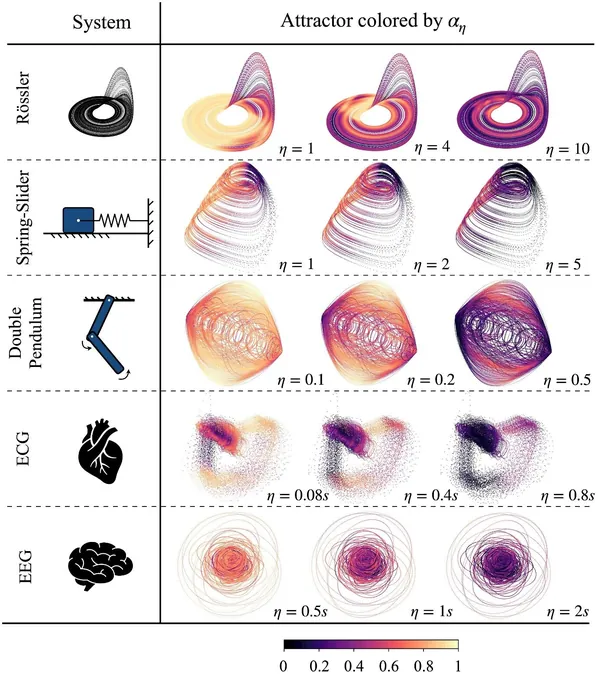
Unlocking the Secrets of Predictability in Complex Systems
2025-06-04
Author: Arjun
Revolutionizing Predictability Analysis with Time-Lagged Recurrence
A groundbreaking research team has unveiled an innovative method to assess the predictability of complex dynamical systems in a recent study published in the Proceedings of the National Academy of Sciences. This method, named Time-Lagged Recurrence (TLR), stands at the forefront of addressing a critical scientific inquiry: how far into the future can we accurately predict the behavior of a system based on its current state?
The Enigma of Predictability and the Butterfly Effect
Predictability is the key to forecasting future states of any system from its present condition. However, as highlighted in mid-20th century studies, even deterministic systems display unpredictable behavior due to their extreme sensitivity to initial conditions, famously termed the "butterfly effect." This phenomenon signifies how minor uncertainties can snowball, complicating long-term predictions, such as those in weather forecasting.
Time-Lagged Recurrence: A Game-Changer for Predictability Assessment
To address these unpredictability challenges, Assistant Professor Mengaldo and his team have introduced a purely data-driven metric, TLR. Unlike traditional methods requiring knowledge of the system's governing equations, TLR relies solely on empirical data.
Building on the concept of recurrence—when a system revisits a previous state—TLR meticulously analyzes how similar initial conditions evolve over a designated time frame. Essentially, TLR poses a vital question: if the system currently occupies a specific state, do similar past states continue to exhibit similar trajectories in the future? The extent of this similarity ultimately defines the local predictability.
Testing the Robustness of TLR Across Various Systems
To demonstrate TLR's versatility and reliability, the research team applied it to an array of dynamical systems, from classical chaotic models to real-world datasets including ECG and EEG signals, simulated slow earthquakes, and atmospheric conditions. Remarkably, TLR was able to pinpoint known predictability traits effectively. For instance, its application to atmospheric data on Euro-Atlantic circulation patterns revealed variability consistent with existing reforecast studies.
A Multi-Disciplinary Diagnostic Tool for the Future
Assistant Professor Mengaldo asserts that TLR’s robust adaptability makes it an invaluable diagnostic tool across numerous scientific fields, from physics to finance. He speculates on TLR's potential integration with artificial intelligence, proposing it could enhance self-evaluation within AI models, refining their predictive accuracy in time-series data based on current states.
Looking Ahead: TLR's Future Applications
With its ability to analyze any complex dynamical system, TLR could significantly enhance forecasting expectations, particularly in terms of stakeholder communication. By identifying when systems become less predictable, stakeholders can adjust their strategies accordingly. TLR is not just a theoretical construct; it embodies the future of data-driven analysis in a rapidly evolving world.
Meet the Innovators Behind TLR
This pioneering research was led by Assistant Professor Gianmarco Mengaldo at the National University of Singapore, along with his doctoral student Chenyu Dong and a collaborative team that includes experts from France, the UK, and more, expanding the reach and implications of this transformative discovery.


 Brasil (PT)
Brasil (PT)
 Canada (EN)
Canada (EN)
 Chile (ES)
Chile (ES)
 Česko (CS)
Česko (CS)
 대한민국 (KO)
대한민국 (KO)
 España (ES)
España (ES)
 France (FR)
France (FR)
 Hong Kong (EN)
Hong Kong (EN)
 Italia (IT)
Italia (IT)
 日本 (JA)
日本 (JA)
 Magyarország (HU)
Magyarország (HU)
 Norge (NO)
Norge (NO)
 Polska (PL)
Polska (PL)
 Schweiz (DE)
Schweiz (DE)
 Singapore (EN)
Singapore (EN)
 Sverige (SV)
Sverige (SV)
 Suomi (FI)
Suomi (FI)
 Türkiye (TR)
Türkiye (TR)
 الإمارات العربية المتحدة (AR)
الإمارات العربية المتحدة (AR)